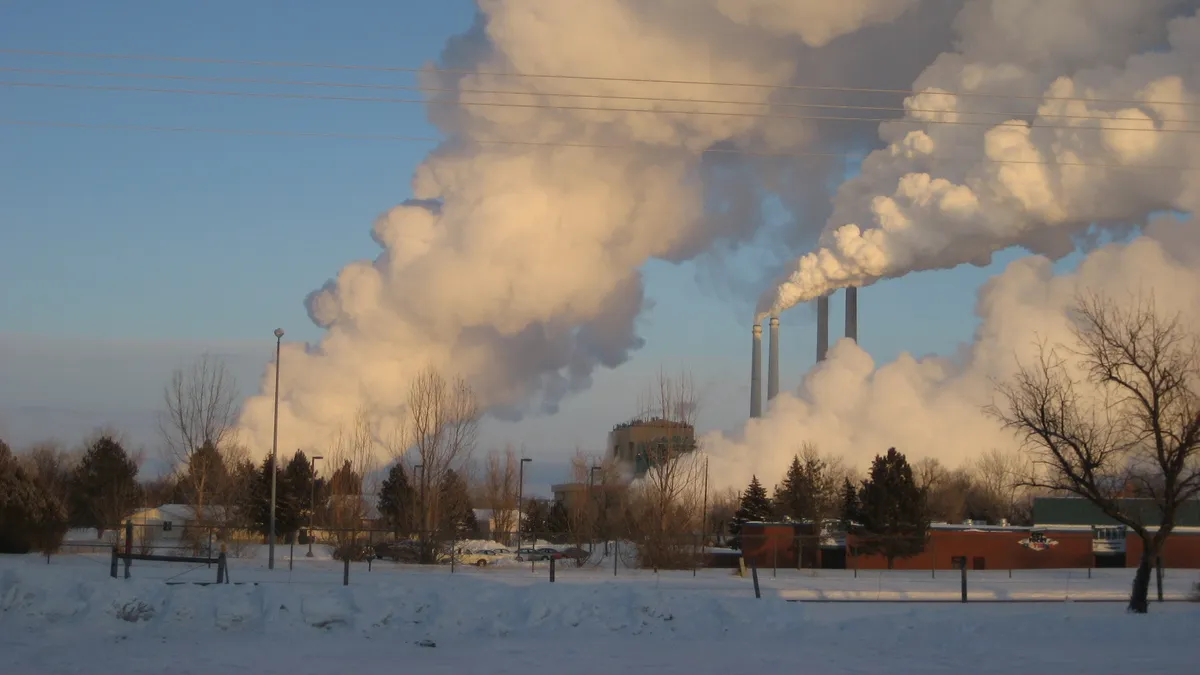Dive Brief:
-
Coal plants are increasingly operating as cyclical or load-following generation units, as the power market becomes more saturated with intermittent resources, according to a Jan. 24 whitepaper from the National Association of Regulatory Utility Commissioners (NARUC).
-
Particularly in states with a high renewables penetration, such as wind-heavy Kansas, Oklahoma and Iowa, coal-fired power plant operations have changed dramatically, which poses physical and financial risks to the facilities, according to the paper. Overall coal capacity factors, or how much actual power the plants generate versus how much they're capable of generating, dropped to 54% in 2018, down from 74% in 2008.
- "There's a lot of talk going on about how coal plants are operating or what's happening with the coal fleet," Wyoming Public Service Commission Chair Kara Fornstrom, who moderated a webinar on the topic, told Utility Dive. "To be able to look at those charts and see the significant change in this in the last 10 years in terms of [coal plant] capacity factors and what they're operating at, compared to what they were designed to operate at … those numbers are just pretty startling."
Dive Insight:
Coal plants are becoming increasingly less economic to operate as a baseload resource, according to the Union of Concerned Scientists, and more utilities across the Southwest Power Pool and in the Midwest are cycling or load-following as their power prices are unable to compete. Though the report is consistent with findings of noneconomic coal dispatches from UCS and Sierra Club, environmental groups split off from the report authors when it comes to how markets should respond.
The power system needs flexible, backup resources paired with intermittent renewables, and proper methods to compensate those resources, which don't currently exist, according to Energy Ventures Analysis Energy and Environmental Markets Manager and lead author of the report Phillip Graeter.
"[T]here does not exist a proper compensation mechanism that adequately pays backup flexible power generation, be it from natural gas, coal, or energy storage, to provide the needed backup during times of generation loss from these renewable resources," he told Utility Dive in an email, adding generation loss "can account for more than 60% of generation in any given hour in power markets like [the Southwest Power Pool (SPP)] at this time."
The Midcontinent ISO and PJM Interconnection are both in the process of developing new market mechanisms to support these changes, including a day-ahead market forecast and pricing tools to mitigate overnight financial losses, respectively. Meanwhile, the Electric Reliability Council of Texas and SPP have "acknowledged" such mechanisms are necessary, the report finds.
"What I think is important is that the markets understand that this is what's going on [and] this report helps them to do that and that they will start down the path of at least considering compensation for certain attributes that these kind of facilities provide to the grid," said Fornstrom.
Though environmental groups agree flexible resources are needed to be paired with renewables, what this report should really tell states and market operators is that high startup and shutdown costs should be included in tariffs, and incentives should not encourage coal operators to run their plants outside of merit order, Sierra Club Senior Strategy and Technical Advisor Jeremy Fisher told Utility Dive.
And although the report makes the argument that higher operation costs warrant better compensation in states and markets, Fisher said the report is just evidence that fewer plants are economic than they had initially thought.
"I don't see this report as necessarily antithetical to anything that we've said about coal being non economically dispatched," he said. "It lends a little bit of color, [but] I think some of the directions it has taken are missing the point to a large extent."
Plants only operated at their highest efficiency capacity, 80%, 37% of the time in 2018, down from 55% in 2008, and plants spent more than 18% of the time operating below 60%, down from 12% ten years earlier.
In response to changing conditions, coal plants are left with two main operating options: to shut down completely or change their electric output.
Coal plants in general were not built to operate cyclically, and lack the flexibility and natural load-following capabilities of simple and combined cycle natural gas plants. Operating coal units in this way can lead to efficiency losses and high ramp rates are becoming more common.
All this can lead to physical issues for the units including thermal fatigue, corrosion and other strains on the facility, which can further ramp up operation and maintenance costs, as well as lead to increased plant outages, the report notes.
The paper "really makes it clear that we're asking coal plants to do things that they weren't constructed to do, and that there are costs associated with that," said Fornstrom.
And because plants are making less money to fund the upgrades that would be necessary to finance some of this maintenance, operators "find themselves in a vicious cycle," according to the report.
Fisher said groups like Sierra Club have asked utilities about these impacts in resource planning proceedings they've been involved in, but never received a "firm assessment" from utilities that these higher costs exist.
"I appreciate that we get better transparency into the clunkiness and potential impacts," he said. But although the report largely credits high ramp rates to an increase in wind power on the grid, Fisher said the report fails to note that coal's marginal economics are what is leading it to operate less and hit high ramp rates.
"The reason that coal is increasingly ramping on our electricity system today is because it is increasingly non economic to continue operating on an hour by hour basis," he said.
Efficiency improvements and more guided operations could all help, according to the report but so could greater dispatches of resources such as energy storage and demand-side management, as well as better curtailment of wind and solar resources during times of high generation or low demand.














